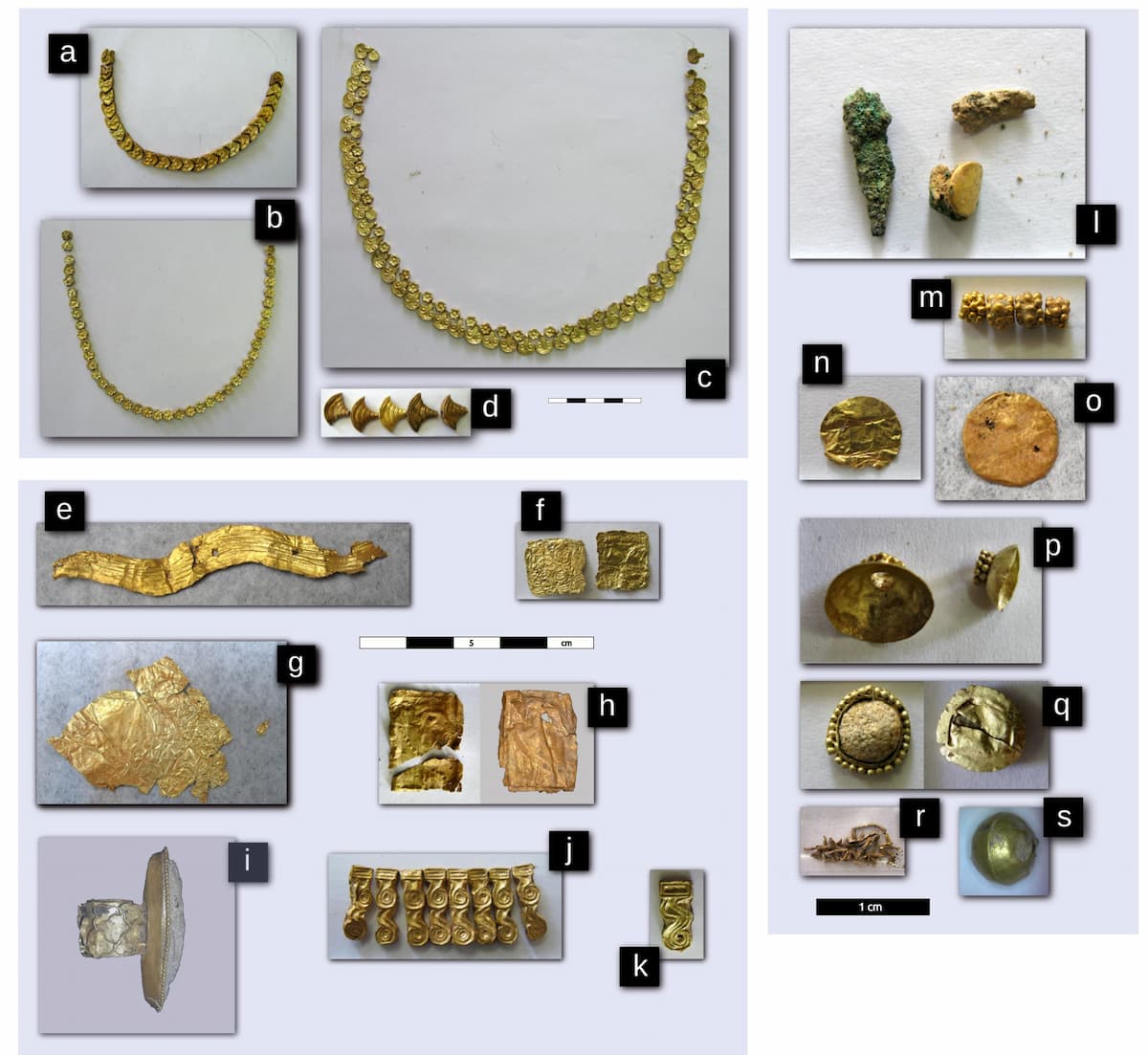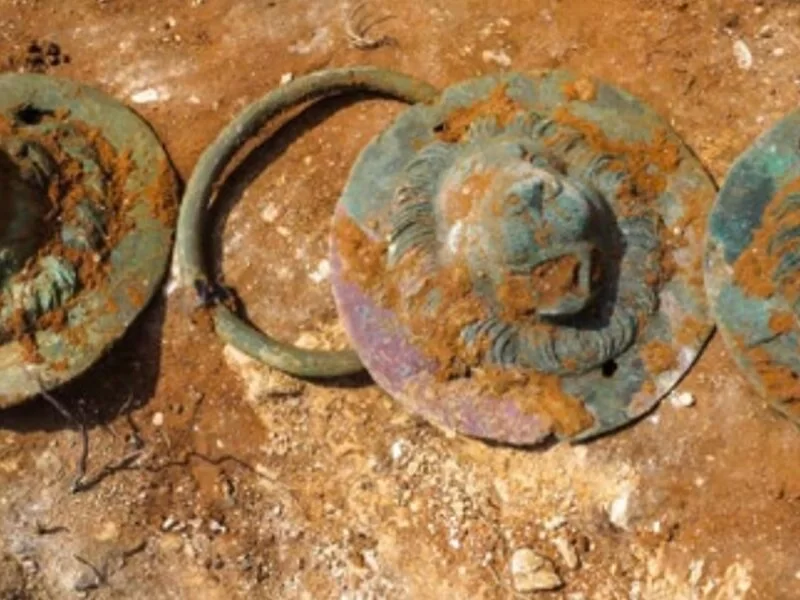A team of researchers has analyzed more than 165 gold objects found in four monumental tombs in the Bay of Volos, in the Greek region of Thessaly, revealing fascinating details about how Mycenaean craftsmen worked with this precious metal more than 3,500 years ago. The study, published in the Journal of Archaeological Science: Reports, offers the first comprehensive investigation of Mycenaean goldsmithing in this key area of the ancient world, known for its connection with the myth of the Argonauts and the Golden Fleece.
The analyzed jewelry comes from four tholos tombs excavated in Dimini and Volos, including the Kazanaki tomb, discovered intact in 2004. This particular tomb is an archaeological treasure: it contained seven burials (adults and children) and more than 150 gold objects, ranging from decorated beads to discs and weapon ornaments. The other three tombs, in Kapakli, Lamiospito, and Toumba, had been looted in antiquity, but they still preserved valuable pieces.
The Mycenaeans, the civilization that dominated Greece between 1600 and 1100 BCE, used these objects in funerary rites to accompany high-status deceased individuals. Many of the pieces, such as gold discs or embossed beads, were so fragile that researchers believe they were made exclusively for funerals, not for everyday use. They were like symbolic offerings, perhaps something the deceased did not wear in life but needed in the afterlife, the study explains.
The Art of Working Gold Without Waste
One of the most interesting findings is how Mycenaean craftsmen made the most of their gold. For example, with only 10 grams of pure gold, they could make about 200 small circular sheets to decorate funerary clothing. For more elaborate objects, like rings or weapon ornaments, they used more advanced techniques, such as granulation (small gold spheres soldered together) or cloisonné (compartments filled with colorful materials).

Simpler jewelry, like necklace beads, was made by joining two gold sheets: one flat on the back and another decorated on the front. The researchers found no evidence of soldering on these pieces, suggesting they were joined mechanically by folding the edges. This indicates that they were probably produced in local workshops using simple methods, perhaps by craftsmen who were not gold specialists, the report notes.
In contrast, jewelry showing signs of wear, such as rings or weapon caps, was made by expert goldsmiths and used in life. These objects required advanced skills and often featured details such as spirals, flowers, or human heads in relief.
The Mystery of “Artificial” Gold
Chemical analysis of the gold revealed that the Mycenaeans of Thessaly mixed natural gold with copper and silver to achieve different tones. Most of the pieces contain between 4% and 35% silver and up to 5% copper, suggesting they deliberately manipulated the alloys. They did not use pure gold, but rather mixtures that could have come from local rivers or streams, where gold is naturally found mixed with other metals, the study points out.
One curious fact is that the necklace beads from each tomb have a similar chemical composition, indicating they were made in batches, possibly for specific burials. In Kazanaki, for instance, researchers identified three distinct groups of gold discs, which could correspond to three phases of tomb use or to different burials.
When comparing this jewelry with that found in the Argolid (the region of Mycenae and other Mycenaean centers), the researchers discovered that the Thessalian objects follow a more uniform chemical pattern. In contrast, the Argolid shows greater variety, including reddish-toned beads found in Prosymna, which could imitate Egyptian techniques to create “rose gold.”

Although some pieces, like papyrus-shaped beads, resemble Egyptian styles, the study clarifies that Mycenaean goldsmithing had its own characteristics. For example, unlike the Egyptians, the Mycenaeans did not use complex soldering techniques or include platinum in their alloys, a typical feature of Egyptian gold.
Centralized Workshops or Traveling Craftsmen?
A key question is whether this jewelry was made in local workshops or came from specialized centers. The study suggests that simpler pieces, such as discs and beads, may have been made near the tombs, perhaps using imported gold sheets. In contrast, more elaborate jewelry, such as inlaid rings, likely came from regional workshops serving the elite.
The production of funerary jewelry did not require year-round specialists in each settlement, the research explains. This could explain why few gold workshops have been found in Mycenaean sites, despite the abundance of jewelry in the tombs.
This study reveals the technical secrets of Mycenaean goldsmiths and shows how Thessaly, often considered a peripheral region, had its own well-defined artisanal traditions. The objects from the Bay of Volos, from the delicate gold flowers of Kapakli to the enigmatic ornaments with human heads from Kazanaki, bear witness to a complex society that combined local influences with long-distance connections.
Although questions remain — such as the exact origin of the gold or the organization of the workshops — this research opens a unique window into a world where the most precious metal was not only a symbol of power but also a bridge between the living and the dead. As the study concludes: Mycenaean gold from Thessaly was not just a material, but an expression of identity, status, and beliefs that transcended death.
SOURCES
María F. Guerra, Goldworking in Mycenaean Thessaly: Technological study of the gold objects from the four tholos tombs in the Bay of Volos. Journal of Archaeological Science: Reports, Volume 64, June 2025, 105129. doi.org/10.1016/j.jasrep.2025.105129
Discover more from LBV Magazine English Edition
Subscribe to get the latest posts sent to your email.











